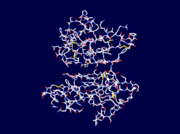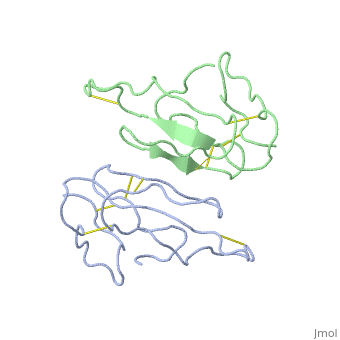Alpha-bungarotoxin
From Proteopedia
Alpha-BungarotoxinAlpha-Bungarotoxin (α-BGT) is a nicotinic cholinergic antagonist that is found within the venom of Bungarus multicinctus, a South-asian snake belonging to a group commonly known as kraits. Belonging to the Elapidae Family, which consist of cobras, kraits, tiger snakes, and mambas, the venom of Bungarus multicuntus is a complex mixture of many different molecules[1] α-BGT belongs to a family of homologous proteins that act as a neurotoxic agent in the venom of these snakes. α-BGT is known to bind irreversibly to the acetylcholine receptor found at the neuromuscular junction, causing respiratory failure, paralysis, and death, as well as play an antagonstic role in binding the α7 nicotinic acetylcholine receptor in the brain. General StructureA large amount of highly homologous snake neurotoxins have been sequenced (>60), and can be grouped into two major classes. Short neurotoxins are between 60-62 amino acids long, and consist of four disulphide bonds, and long neurotoxins - which α-BGT falls under - are between 71-74 amino acids long and contain five Disulphide Bonds per subunit. α-BGT contains 74 amino acids, and is one of the major components of Bungarus multicuntus venom. Chemical modifications of individual residues has shown that no single amino acid is mandatory for binding, signifying the significance of structure, rather than sequence, and the concept of multicontact interaction with the acetylcholine receptor [2]. The importance of structure in binding has been tested by Love & Stroud (1986)[1] by determining whether the homology and common mode of action of neurotoxins is facilitated by the three-dimensional structure. Using X-ray crystallography at various resolutions, neurotoxins erabutoxin and cobratoxin were compared to that of α-BGT to determine the level of three-dimensional similarity. The overall size of the molecule is 40 x 30 x 20 Å, with two outer loops folded toward one another. α-BGT is "flat" enough to contain no hydrophobic core, but does contain a few uncharged sidechain groupings[1]. The protein is a dimer, and consists of two seperate subunits: Domain A Domain B
Secondary structure & Disulphide bondsHydrogen bonds present allow for an antiparallel β-sheet, which is the only secondary structure present and acts to keep the second and third loops roughly parallel[1]. The three-loop structure is preserved by four invariant disulphide bridges, which are present in all neurotoxins. The fifth disulphide bridge is located at the end of the second loop, and can be reduced without any effect on the binding affinity of the molecule, while a total loss of toxicity is demonstrated when the remaining disulphides are reduced, producing a random coil structure much different than the native conformation[1]. The comination of the multiple disulphide bonds and small amount of secondary structure is the cause for the extreme stability of neurotoxins like α-BGT, providing resistance to denaturing forces such as boiling[3] and strong acids[4]. Functionally important residues contained in the extended loops are preserved by the clustering of disulphides near one end of the α-BGT molecule. This is due to an increased amount of flexibility in these extended loops, which is possibly quite important for interaction with acetylcholine receptors. FunctionsElapidae neurotoxins bind specifically and tightly (with a very high affinity) in a non-covalent manner to the nicotinic acetylcholine receptors in cholinergic synapses of their victims. This prevents normal neurotransmitter-induced channel opening, which in turn blocks postsynaptic membrane depolarization[1], classifying the molecule as a postsynaptic neurotoxin. Neuromuscular acetylcholine receptor bindingThe irriversible and competitive binding to the acetylcholine receptor by α-BTG can be devastating to an organisms health due to its ability to block the receptors activity. Released acetylcholine diffuses across the gap separating nerve and muscle cells, interacting with specific receptors associated with the postsynaptic muscle membrane. This produces an increase in permeability in the membrane to both sodium and potassium ions. Toxins purified from the venoms of Bungarus multicinctus disrupt neuromuscular transmission by blocking the postsynaptic response to acetylcholine. In addition, a-bungarotoxin blocks the response to acetylcholine of denervated muscle fibers [5] α7 nicotinic acetylcholine receptor bindingResponse to sensory stimuli and seizure genesis has been linked to nicotinic mechanisms[6], which are mediated by two major classes of receptors: Ganglionic type, and neuromuscular type, which pharmacological analysis of seizure genesis and habituation in the rat brain is thought to be mediated by the latter type [7]. α-BGT demonstrates this relationship due to its prominent binding in the CA3 region of the hippocampus [8]. See also: |
| |||||||||||
3D structures of Alpha-bungarotoxin
Additional Resources
For additional information, see: Toxins
References
- ↑ 1.0 1.1 1.2 1.3 1.4 1.5 Love RA, Stroud RM. The crystal structure of alpha-bungarotoxin at 2.5 A resolution: relation to solution structure and binding to acetylcholine receptor. Protein Eng. 1986 Oct-Nov;1(1):37-46. PMID:3507686
- ↑ Karlsson, E. (1979) in Lee,C Y (ed), Handbook of Experimental Pharmacology Springer-Verlag, Berlin Vol 52, pp 159-212;Low, B.W. (1979) In Lee,c Y (ed). Handbook of Experimental Pharmacology Springer-Verlag, Berlin, Vol 52, pp 213-257.
- ↑ Tu AT, Hong BS. Purification and chemical studies of a toxin from the venom of Lapemis hardwickii (Hardwick's sea snake). J Biol Chem. 1971 May 10;246(9):2772-9. PMID:5554293
- ↑ Chiceportiche, R. Rochat, C. Sampien, F. Lazdunski, M. (1972) Biochemistry 14, 2081-2091;Chen, Y.H. Tai, J.C. Huand, W.J. Lau, M.Z. Hung, M.C. Lai, M.D. Yang, J.T. (1982) Biochemistry 21 2592-2600
- ↑ Berg DK, Kelly RB, Sargent PB, Williamson P, Hall ZW. Binding of -bungarotoxin to acetylcholine receptors in mammalian muscle (snake venom-denervated muscle-neonatal muscle-rat diaphragm-SDS-polyacrylamide gel electrophoresis). Proc Natl Acad Sci U S A. 1972 Jan;69(1):147-51. PMID:4333037
- ↑ Freedman R, Wetmore C, Stromberg I, Leonard S, Olson L. Alpha-bungarotoxin binding to hippocampal interneurons: immunocytochemical characterization and effects on growth factor expression. J Neurosci. 1993 May;13(5):1965-75. PMID:8478687
- ↑ Miner LL, Collins AC. Strain comparison of nicotine-induced seizure sensitivity and nicotinic receptors. Pharmacol Biochem Behav. 1989 Jun;33(2):469-75. PMID:2813485
- ↑ Hunt SP, Schmidt J. The electron microscopic autoradiographic localization of alpha-bungarotoxin binding sites within the central nervous system of the rat. Brain Res. 1978 Feb 17;142(1):152-9. PMID:626914
Proteopedia Page Contributors and Editors (what is this?)
Alexander Berchansky, Michal Harel, Simon Loewen, David Canner


